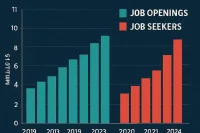Why living in London has become impossible reveals a stark contradiction in one of the world’s wealthiest cities, where over 200,000 millionaires coexist with more than 1 in 4 people living in poverty. Despite being a global finance center with more private jet traffic than anywhere else in Europe, London has undergone a dramatic transformation that has made it unaffordable for most residents. The city’s housing crisis has reached catastrophic proportions, with homelessness 8 times the national average and median rent increasing by 80% in just 8 years.
The statistics paint a devastating picture: Londoners spend 46% of their income on housing, 50% more than the rest of the UK, while wages adjusted for inflation haven’t risen since 2008. Despite earning more than residents elsewhere, high-earning Londoners rank in the bottom 5% for spending power after housing costs. This has created a situation where people earn more but live worse, with desperate times leading to a 35.5% surge in shoplifting and basic products being locked in plastic boxes to prevent theft.
The crisis stems from decades of policy decisions that have transformed London from an accessible capital into an exclusive enclave for the wealthy, with nearly 45% of central London property purchases made by foreign buyers while 100,000 homes sit empty.
The Housing Crisis: A Perfect Storm of Policy Failures
This crisis begins with a housing emergency that has its roots in decisions made nearly a century ago. The 1930s green belt policy, designed to protect countryside and preserve air quality, has created an artificial constraint on development that has had devastating long-term consequences.
Today, three times the land area of Greater London is protected, meaning there’s very little land available for building. While 52,000 houses are needed each year, London has only been building 30,000, creating a deficit of 1.1 million homes needed to reach the European average of houses per person.
The situation was compounded by Margaret Thatcher’s 1980 Housing Act, which introduced the Right to Buy scheme. While this helped 316,000 families purchase their homes at discounts up to 70%, councils weren’t allowed to reinvest the sales proceeds into building more housing. This created a decades-long decline in public housing stock, resulting in 330,000 households on waiting lists for social housing and 180,000 people in temporary accommodation.
The Foreign Investment Problem: Locals Priced Out
This situation is largely due to the city’s transformation into a global investment destination rather than a place to live. In 2023 alone, 45% of central London property sales were made by foreign buyers, creating a market where most people buying homes aren’t interested in living in the city.
This foreign investment has driven prices up by 46% in central London over the past decade, making the city one of the world’s most attractive real estate investments. Studies show that without foreign investment, average prices would have dropped from £215,000 to £174,000 – a 19% difference that would make housing more accessible to locals.
The result is a market where houses are bought as safe investments rather than homes, creating more demand than actual need. This has left Londoners paying for these investments while being priced out of their own city.
The Privatization Disaster: Public Services Sold Off
This crisis extends beyond housing to encompass the privatization of essential services. The 1989 privatization of Thames Water, which supplies all water for the city, has become a case study in how selling public utilities can lead to catastrophic failures.
Since privatization, Thames Water has failed to complete 100 infrastructure upgrades to reduce sewage spills while paying out over £7 billion in dividends to investors. The company’s debt has risen to £18 billion, roughly 80% of its value, and it’s now on the brink of collapse.
The result is that regular Londoners are being forced to rescue a failing company through a 31% increase in water bills – the biggest increase since privatization in the 1980s – while the company announces plans to pay out an extra £2 billion to shareholders.
The Cost of Living Crisis: Everything Becomes Unaffordable
This situation is compounded by a broader cost of living crisis that has seen prices rise by 35% in just 4 years. Energy bills have increased from £1,000 to £1,700 per year, while everyday goods have risen by 25% excluding fuel and housing.
London’s older housing stock means energy bills are typically 20-30% higher than the rest of the UK, even without these price increases. The city’s ultra-low emission zone charges £12.50 per day for non-compliant vehicles, while congestion charges add £15 per day in the city center – costs that disproportionately hit working-class Londoners who can’t afford newer cars.
Public transport costs are among the highest in the world, being 1.5 to 2 times more expensive than similar global cities, while only 40% of trains have air conditioning despite summer temperatures regularly exceeding 30°C.
Hire for AI’s Most In-Demand Roles
From AI engineers to data scientists and product managers, demand for AI talent is surging across industries. Employers can secure top professionals in competitive fields by posting their roles where ambitious candidates are actively searching. Post your job on WhatJobs today and connect with skilled talent ready to meet the market’s growing AI needs.
Post a Job Free for 30 Days →The Tax Burden: Paying More for Less
This crisis includes an increasingly heavy tax burden that hits Londoners disproportionately hard. Britain faces its highest tax burden since World War II at 34% of GDP, with council tax nearly tripling in some London boroughs since the 1990s.
The government’s approach of freezing tax thresholds means that when wages increase with inflation, people are pushed into higher tax brackets despite not being able to buy more with their higher wages. Since Londoners earn 30-40% more than people elsewhere, they pay higher amounts of income tax, even though their higher wages are swallowed up by housing costs.
This creates a situation where Londoners pay disproportionately more than the rest of the UK while receiving worse public services due to underinvestment since 2008’s austerity program.
The Crime Wave: Desperation Breeds Lawlessness
This situation includes the city’s deteriorating safety situation, with overall crime increasing by 25% last year. Research suggests that a 10% increase in the cost of living increases crime by 8%, and Londoners have clearly felt this effect.
Shoplifting rose by 35.5% – the highest increase of any crime type – while violent and sexual offenses remain the most common crimes. This has created a situation where living in London means being at serious risk just for leaving your expensive house, made more difficult when 50% of Londoners don’t trust the city’s police force.
The crime wave reflects the desperation created by unaffordable living costs, with people resorting to theft to meet basic needs in a city where even essential items must be locked away to prevent theft.
The Infrastructure Collapse: A City in Decay
This crisis includes the city’s crumbling infrastructure, which has been underinvested in for decades. Hammersmith Bridge has been closed since 2019 due to safety concerns and might not reopen until 2035, with repair costs spiraling to £250 million.
Across the city, 200 out of 500 bridges are rated poor or in very poor condition, while London councils face a £17 billion road maintenance backlog. One in six students study in schools that need major work, reflecting the broader underinvestment in public services.
This infrastructure decay makes daily life more difficult and expensive, with longer commutes, unreliable services, and deteriorating public spaces that reduce quality of life for all residents.
The Social Impact: Isolation and Despair
This situation has profound social consequences that extend beyond financial hardship. Middle-class Londoners are being pushed out to commuter towns beyond the green belt, creating the UK’s longest average commute at 81 minutes.
This displacement means people are far from their support networks and feel more isolated, with half of all Londoners reporting feeling lonely. The financial stress is making people more anxious about the future, with around a third saying it’s a good time to save – the highest number since 2007.
This leads to less money spent on restaurants, leisure, or entertainment, creating a much lower sense of life satisfaction and a city that’s becoming increasingly divided between the wealthy and the struggling.
The Productivity Crisis: Stagnant Wages and Economic Decline
This crisis includes the UK’s productivity crisis, with wages stagnating since the financial crisis. Adjusted for inflation, the average Londoner earns 5% less today than in 2008, while other OECD countries have seen incomes grow by around 9%.
If wages had continued rising at pre-2008 levels, Londoners would be earning £11,000 more per year. Instead, they now face the highest unemployment rate in the UK at 6%, with nearly one in five young people out of work or education.
This productivity crisis reflects broader economic problems that have made London less competitive internationally, despite being one of the most economically productive cities in the world, contributing over £500 billion to the UK economy annually.
The Path Forward: Solutions for a Sustainable London
This crisis doesn’t mean the situation is hopeless. The solution comes down to one word: supply. By building more affordable homes, the government could reduce demand, ease prices, and make it possible for more people to live in the capital.
Reforming the green belt could provide part of the solution – if just 1% were made available for development, it would create 140,000 new homes without sacrificing natural beauty. London’s brownfield sites could provide over 400,000 homes if fully developed.
The government could also make it harder to buy homes without living in them by increasing taxes on empty properties, implementing progressive taxes on expensive properties purchased by non-residents, and expanding the housing stock through purchasing existing homes for affordable rental.
Frequently Asked Questions
What are the main reasons why living in London has become impossible?
The main reasons include housing costs rising 80% in 8 years, foreign investment pricing out locals, privatization failures in public services, high tax burdens, crime increases, infrastructure decay, and stagnant wages despite high living costs.
How does why living in London has become impossible affect different income groups?
Why living in London has become impossible affects all income groups, with middle-class residents being pushed to commuter towns, working-class people facing the highest cost burdens, and even high earners ranking in the bottom 5% for spending power after housing costs.
What historical policies contributed to why living in London has become impossible?
Historical policies include the 1930s green belt restrictions limiting development, Margaret Thatcher’s Right to Buy scheme without replacement housing, and the 1989 privatization of public utilities like Thames Water that prioritized profits over service.
What solutions exist for why living in London has become impossible?
Solutions include building more affordable homes, reforming green belt policies, developing brownfield sites, implementing taxes on empty properties and foreign buyers, and expanding public housing stock to make the city accessible to all income levels.
A Real-World Example: Sarah’s Struggle to Stay in London
Sarah Martinez, a 28-year-old marketing coordinator from South London, exemplifies why living in London has become impossible for young professionals. Despite earning £35,000 per year – above the UK average – Sarah spends 60% of her income on rent for a small one-bedroom flat.
“I love London, but why living in London has become impossible is something I experience every day,” Sarah explains. “My rent has increased by £300 per month in two years, and I’m constantly choosing between heating and eating. I’m considering moving back to Manchester where I could afford to save money and have a better quality of life.”
Sarah’s situation reflects the broader crisis, where even professionals with good jobs struggle to maintain basic living standards. She’s had to give up hobbies, social activities, and even basic comforts to afford her rent, while watching foreign investors buy properties in her neighborhood that sit empty.
“Why living in London has become impossible taught me that this city is no longer for people like me,” Sarah says. “I’m part of a generation being priced out of the capital, and it’s heartbreaking to see the city I love become unaffordable for ordinary people.”
Sarah’s experience demonstrates how the housing crisis affects real people, forcing them to choose between their dreams and financial security in a city that was once accessible to working-class families.




